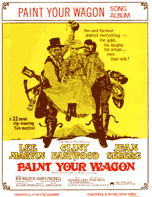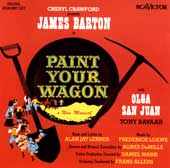PAINT YOUR WAGON

A musical play in 2 acts, 15 scenes; Music by Frederick
Loewe: Libretto & Lyrics by Alan Jay Lerner
Shubert Theatre, Broadway - 12 November, 1951 (289 perfs)
Her Majesty's Theatre, London - 11 February, 1953
Within a few years of writing Brigadoon and Paint Your Wagon, the writers went on to conceive the greatest musical of any age, My Fair Lady and the loveliest film, Gigi. The quality of their later works shows itself abundantly in Paint Your Wagon.
Synopsis
It is a fine story about prospectors in the Californian Hills of 1853 and the finding of gold which turned the desert wastes into towns and the losing or it turning towns into desert wastes; a miners' uneducated daughter left alone to cope with the tough crews; and the importation of a wagon-load of Fandangos and the loves and jealousies which follow.

Music and lyrics are fashioned in pattern with the story. There are no odd or interpolated songs out of character - all have great impact value. The songs include "I Talk To the Trees", "Carino Mia" and "Another Autumn" sung by Julio, a youngish baritone in love with the teenage Jennifer, who sings "How Can I Wait For Tomorrow?" and "All For Him" in a deep, modern singing voice.
Her father, Ben, is a wonderful role needing a good actor singer and comedian all in one. He has the sentimental song "I Still See Elisa", the comedy song "In Between" and the rip-roaring and amusing "Whoop-ti-ay". A lot of men are required to play the rough and rugged gold miner and are led by Steve (baritone) in the famous "They Call The Wind Maria". There is one highly amusing trio, "The Prayer", which, at first glance, might appear sacrilegious but, in fact, is not so.
Apart from chorus singers, good male and female dancers are needed to perform numbers originally created by Agnes de Mille, and which include solo dances. There are many scenes, mostly of the Californian Hills, but none difficult. Men are dressed like those one sees in a typical television "Western" and the girls, though in period, wear many flamboyant costumes.
THE STORY
(1853 during the Californian Goldrush)
The story begins with Jennifer, Ben Rumson's uneducated sixteen year old daughter, discovering gold whilst running her hands through the dirt. News travels fast and prospectors from all around rush to Rumson Creek to make their fortune.
Being the only female around Jennifer has to deal with many 'frustrated' gold miners, but eventually strikes up a close friendship with a Mexican called Julio. Ben realises that Jennifer is not such a "little girl" anymore and decides it is time for her to leave on the next Eastbound coach to be educated. Jacob, a middle aged Mormon, arrives at Rumson and is only allowed to stay on the condition that he auctions one of his two wives. After some deliberation he agrees and Elizabeth is sold to Ben, much to Jennifer's disgust who packs her bags and runs to Julio's cabin in the mountains.
After some discussion she decides to go East to school, and return when Julio has made his fortune. Jake, a miner in his thirties, makes his money, builds a Music Hall and consequently sends for his wife, Cherry. With her she brings a wagon load of fandangos - much to the men's delight! As with all good things, the gold begins to run out and slowly the men pack up and leave. Jennifer returns, unexpectedly, intending to marry Julio whom she later learns has left for the mountains in search of gold. (She is now very noticeably a "young lady"!) News that gold has been struck forty miles away heralds a new gold rush, although Ben decides he cannot leave Rumson, his home town. The story ends when Julio returns, by chance, and Jennifer runs into his arms!
Cast
|
|
|
|
Synopsis of Scenes
ACT I
SCENE I A California hilltop, May, 1853.
SCENE 2 Various parts of California.
SCENE 3 In front of Salem's store, July.
SCENE 4 Outside Rumson's cabin, two months later.
SCENE 5 Rumson's cabin, September.
SCENE 6 A hillside near Rumson.
SCENE 7 Dutchie's saloon, the following Sunday.
SCENE 8 Outside Rumson's cabin, that night.
SCENE 9 Julio's cabin.
SCENE 10 On the way to the Square.
SCENE 11 Rumson Square, immediately following.
ACT II
SCENE 1 Jake's Palace, November, 1854.
SCENE 2 The diggin's, two weeks later.
SCENE 3 Rumson's cabin, December.
SCENE 4 A street in Rumson, evening, the next day.
SCENE 5 Jake's Palace, immediately following.
SCENE 6 A hillside near Rumson, the next day.
SCENE 7 Rumson Square, the following Spring.
Musical Numbers
Act I
|
Act II
|
INSTRUMENTATION
(Total number of books = 20) *
|
|
*Instruments of the Orchestra in the New York Production.
WOODWINDS (W/'winds.):
1st Player: Flute (Fl.); Piccolo (Pice.): Clarinet (Clar.); Alto Sax.
2nd Player: Flute; Piccolo; Clarinet; Alto Sax.
3rd Player: Oboe; Clarinet; Tenor Sax.
4th Player: Clarinet; Bass Clarinet; Tenor Sax.
5th Player: Bassoon (Bssn.); Flute; Piccolo; Clarinet; Bass Clarinet; Baritone Sax.
BRASS (Br.):
3 French Horns (Hn.) 3 Trumpets (Tpt.)
2 Trombones (Trnib.)
1 Percussion (Thnp.; Dr.) I Piano, doubling Celesta
1 Banjo, doubling Guitar (Guit.)
STRINGS (Str.):
8 Violins (Vln.); A and B
2 Violas (Vla.); one doubling Mandolin (hand.)
2 'Celli
2 Basses (Bs.), one doubling Tuba
Discography:
Original 1951 Broadway Cast Recording - RCA Victor - GD 60243